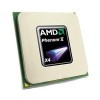- Qualcomm Launches Snapdragon 4 Gen 2 Mobile Platform
- AMD Launches Ryzen PRO 7000 Series Mobile & Desktop Platform
- Intel Launches Sleek Single-Slot Arc Pro A60 Workstation Graphics Card
- NVIDIA Announces Latest Ada Lovelace Additions: GeForce RTX 4060 Ti & RTX 4060
- Maxon Redshift With AMD Radeon GPU Rendering Support Now Available
AMD Phenom II X4 810 & X3 720 Black Edition

Phenom II may have just launched last month, but AMD didn’t want to waste time in following-up with their first AM3-based processors. We’re taking a look at two, including the X4 810 and X3 720 ‘Black Edition’. Both offer great performance at their respective price-points, but the X3 became the more appealing chip, thanks to its overclocking ability.
Page 3 – SYSmark 2007 Preview
Synthetic benchmarks have typically been favored for performance testing, but the results they provide can be fairly abstract, and the methods they use to assign their scores can be dubious at times. By contrast, real-world application benchmarks provide performance metrics that apply directly to real-world usage, and we endeavor to apply both in our performance comparisons.
SYSmark 2007 Preview from BAPCo is a special case, because its synthetic scores are derived from tests in real-world applications. However, we still believe that synthetic benchmarking scores are best used to directly compare the performance of one piece of hardware to another, and not for developing an impression of real-world performance expectations. SYSmark is more useful than most synthetic benchmarking programs in our opinion, because its tests emulate tasks that people actually perform, in actual software programs that they are likely to use.
The benchmark is hands-free, using scripts to execute all of the real-world scenarios identically, such as video editing in Sony Vegas and image manipulation in Adobe Photoshop. At the conclusion of the suite of tests, five scores are delivered: an E-learning score, a Video Creation score, a Productivity score, and a 3D Performance score, as well as an aggregated ‘Overall’ score. These scores can still be fairly abstract, and are most useful for direct comparisons between test systems.
A quick note on methodology: SYSmark 2007 requires a clean install of Windows Vista 64-bit to run optimally. Before any testing is conducted, the hard drive is first wiped clean, and then a fresh Windows installation is conducted, then lastly, the necessary hardware drivers are installed. The ‘Three Iterations’ test suite is run, with the ‘Conditioning Run’ setting enabled. Then the results from the three runs are averaged and rounded up or down to the next whole number.


As far as SYSmark is concerned, the X3 720 and X4 810 are equals. Common logic would tell you otherwise, but as it seems, SYSmark doesn’t swamp the PC with multi-threaded applications constantly, which helped the X3 720 pull ahead in single-threaded segments. The results are quite similar to what many people would experience however. If you are not a major multi-tasker, an extra core on your Quad-Core may very well go to waste (for what it’s worth, the same could be said about a Tri-Core or Dual-Core in some cases).
Although SYSmark delivers fairly accurate results where real-world scenarios are concerned, it is a bit disconcerting to see an E8600 outperform a Q9650. So, let’s see how AMD’s latest creations handle our real-world tests, compared to Intel’s direct competitors.
Support our efforts! With ad revenue at an all-time low for written websites, we're relying more than ever on reader support to help us continue putting so much effort into this type of content. You can support us by becoming a Patron, or by using our Amazon shopping affiliate links listed through our articles. Thanks for your support!





